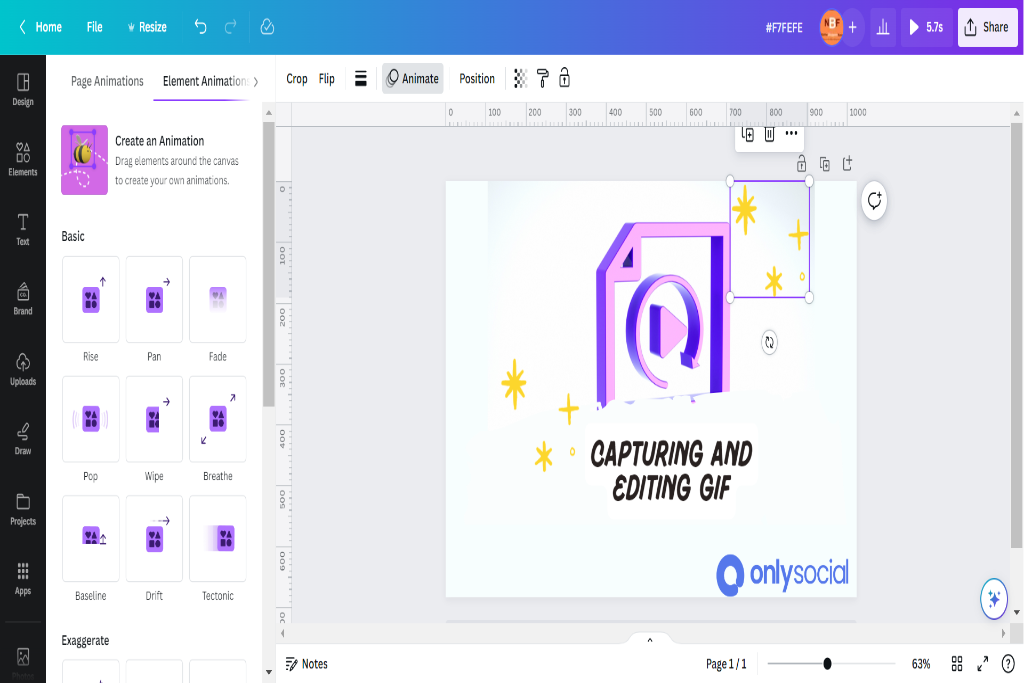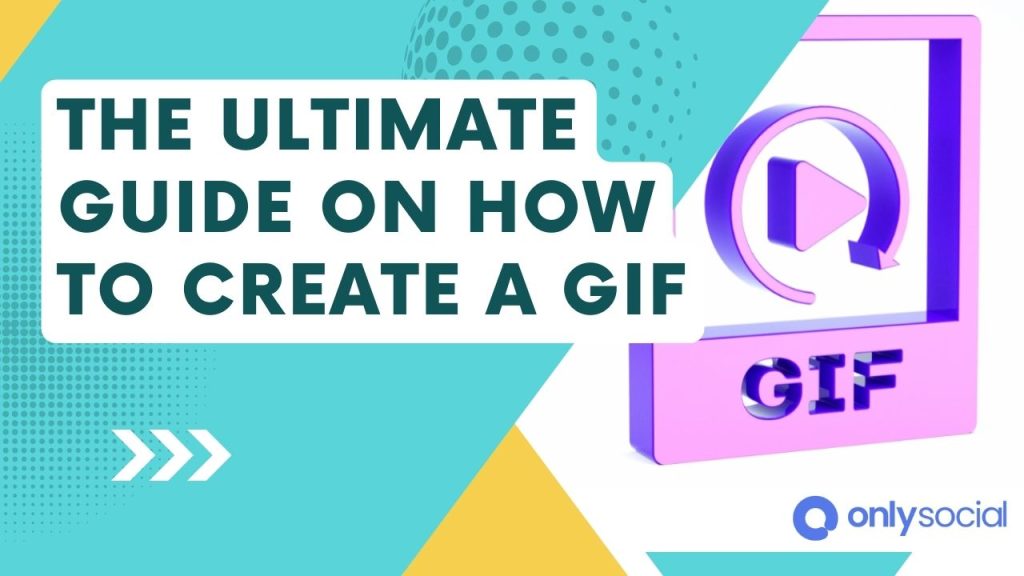Have you ever wondered how those mesmerizing looping animated images, known as GIFs, are made? Well, wonder no more! This ultimate guide is here to walk you through the whole process step by step. Get ready to unleash your creativity and wow the world with your captivating GIFs!
Table of Contents
- 1 Understanding the Magic of GIFs
- 2 Choosing the Perfect Software
- 3 Capturing and Editing Videos for GIFs
- 4 Adding Text and Effects for Extra Flair
- 5 Optimizing and Exporting for Different Platforms
- 6 Sharing and Promoting Like a Pro
- 7 Understanding GIFs: What They Are and How They Work
- 8 Choosing the Right Software for GIF Creation
- 9 Capturing and Editing the Perfect Video for Your GIF
- 10 Adding Text and Effects to Enhance Your GIF
- 11 Optimizing and Exporting Your GIF for Different Platforms
- 12 Sharing and Promoting Your GIF for Maximum Impact
- 13 BONUS
- 14 Frequently Asked Questions
- 14.1 Can I Create a GIF Using Only Images Instead of a Video?
- 14.2 Is It Possible to Create a GIF With a Transparent Background?
- 14.3 Are There Any Copyright Concerns When Using Videos or Images to Create a GIF?
- 14.4 Can I Add Multiple Text Layers to My GIF?
- 14.5 How Can I Ensure That My GIF Plays Smoothly on All Platforms and Devices?
Understanding the Magic of GIFs
GIFs are these fantastic little creations that bring images to life through continuous looping. They’re like tiny windows into a world of infinite possibilities. With GIFs, you can express emotions, tell stories, or add a touch of whimsy to your online presence.
Choosing the Perfect Software
To embark on your GIF-making journey, you’ll need the right tools. Luckily, plenty of software options are available that make GIF creation a breeze. From simple online platforms to advanced editing programs, you can find the perfect match for your needs and level of expertise.
Capturing and Editing Videos for GIFs
Before transforming your videos into GIFs, you must capture and edit them perfectly. Whether you’re shooting original footage or working with existing videos, this step is crucial. You’ll learn how to trim, crop, and adjust the timing to create a seamless and captivating GIF foundation.
Adding Text and Effects for Extra Flair
Now that you have a solid base, it’s time to take your GIFs to the next level. Learn how to add text overlays and effects to make your creations stand out. From witty captions to stunning visual enhancements, the possibilities are endless. Let your imagination run wild!
Optimizing and Exporting for Different Platforms
To ensure your GIFs reach their full potential, optimizing them for different platforms is important. Each platform has specifications and requirements, and you’ll discover the best practices for exporting your GIFs without compromising their quality. Get ready to make your GIFs shine wherever they’re shared!
Sharing and Promoting Like a Pro
What good is a fantastic GIF if no one sees it? In this final section, you’ll learn strategies for effectively sharing and promoting your GIFs. Discover the best channels to showcase your creations and gain the recognition they deserve, from social media platforms to online communities. Get ready to make a GIFtastic splash!
So, are you ready to dive into the beautiful world of GIF creation? Let’s get started and unleash your inner GIF maestro!
Understanding GIFs: What They Are and How They Work
GIFs are a popular file format for displaying animated images on various digital platforms. Understanding their structure and functionality is essential for effectively creating and utilizing them.
GIF stands for Graphics Interchange Format, developed by CompuServe in 1987. It uses lossless compression, meaning it maintains the quality of the image while reducing file size. This makes GIFs ideal for sharing on the internet as they load quickly without sacrificing visual fidelity.
Creating animated GIFs from scratch involves a few key steps. Firstly, you must determine the frames that will make up your animation. Each frame represents an individual image or scene in the sequence. Next, you must arrange these frames to create a smooth animation effect. This can be done using various software programs or online tools specifically designed for creating GIFs.
Additionally, it’s important to consider optimizing your GIF file size reduction techniques to ensure faster loading times and smoother playback. Techniques such as reducing color palettes, minimizing dithering effects, and adjusting frame delays can help achieve this goal.
Choosing the Right Software for GIF Creation
This discussion focuses on the key points of online vs. desktop software for GIF creation, comparing their features, capabilities, and user-friendly interfaces.
Choosing between online and desktop software is important when creating GIFs, as each option offers unique advantages and limitations.
Online Vs. Desktop
When comparing online and desktop options, there are key differences regarding functionality and accessibility.
- Functionality: Online tools often provide a limited range of features compared to desktop software. Desktop software typically offers more advanced editing capabilities, such as adding special effects or adjusting frame timing.
- Accessibility: Online tools can be accessed from any device with an internet connection, making them convenient for users who need to create gifs on the go. On the other hand, desktop software requires installation and may not be easily accessible on all devices.
- Speed: Online tools generally have faster processing times since they utilize cloud-based servers for rendering and converting files. In contrast, desktop software relies on the processing power of the user’s computer, which can impact speed.
- Privacy: Online tools may require uploading files to third-party servers, raising concerns about privacy and data security. Desktop software allows users to keep their files local and eliminates potential risks associated with online file transfers.
Considering these factors, individuals must evaluate their needs before deciding between online tools or desktop software for gif creation.
Features and Capabilities
One important aspect to consider when comparing online and desktop options for gif creation is the range of features and capabilities each platform offers. Online tools often provide a user-friendly interface with basic editing functions, making them suitable for beginners and casual users. However, they may have limited customization options and lack advanced animation techniques. On the other hand, desktop software typically offers more comprehensive features, allowing users to fully customize their gifs with advanced editing tools and techniques. This includes adjusting frame rates, applying special effects, adding text or captions, and creating complex animations. The following table compares some key features between online platforms and desktop software:
| Features | Online Tools | Desktop Software |
|---|---|---|
| Customization | Basic editing options | Advanced customization options |
| Animation Techniques | Limited | Extensive |
User-Friendly Interface
An important consideration when comparing online and desktop options for gif creation is the ease of use provided by each platform’s user-friendly interface. The user-friendliness of an interface plays a crucial role in determining the level of user engagement and satisfaction with the tool.
Regarding design aesthetics, both online and desktop platforms offer various features that allow users to customize their gifs, such as adding text, filters, or stickers. However, there are some key differences between the two options:
- Accessibility: Online platforms are accessible from any device with internet access, while desktop options require installation.
- Speed: Online platforms often have faster rendering times due to cloud-based processing power.
- Offline capabilities: Desktop options allow users to work offline and save their progress locally.
- Advanced editing features: Desktop options offer more advanced editing tools than online platforms.
These factors can help users decide which option best suits their needs regarding user engagement and design aesthetics.
Capturing and Editing the Perfect Video for Your GIF

To capture and edit the perfect video for your GIF, it is essential to employ techniques that ensure optimal quality and visual appeal.
When it comes to capturing techniques, there are several options available. One approach is to use a high-quality camera or smartphone capable of recording videos at a high resolution. This will provide clear and sharp footage, crucial for creating a visually appealing GIF. Additionally, consider using stabilization methods such as tripods or handheld gimbals to minimize shakiness in your videos.
Once you have captured the video footage, editing software is vital in refining your GIF creation. There are various editing software programs available that offer features designed explicitly for creating GIFs. These programs allow you to trim the video, adjust brightness and contrast levels, apply filters or effects, and add text or captions if desired. Choosing an editing software that suits your needs and level of expertise is important.
Adding Text and Effects to Enhance Your GIF
In the previous subtopic, we discussed capturing and editing the perfect video for your GIF. Let’s explore another aspect of creating a captivating GIF: adding text and effects.
- Text Overlay: Adding text to your GIF can provide context or convey a message. Choose a font that complements the content and ensure it is easy to read against the background.
- Filters: Applying filters can enhance the visual appeal of your GIF—experiment with black and white, sepia, or vintage filters to create unique effects.
- Animations: Animated effects can make your GIF more dynamic and eye-catching. Consider adding animated elements such as sparkles, confetti, or motion trails to bring life to your creation.
- Memes: Incorporating popular memes into your GIF can add humor or cultural references that resonate with viewers. You can use meme generators or create original memes using image editing software.
Optimizing and Exporting Your GIF for Different Platforms
This discussion focuses on the optimization and exporting of GIFs for different platforms. Specifically, it explores platform-specific optimization techniques and exporting for social media.
Platform-specific optimization techniques involve tailoring the GIF to suit specific platforms’ technical requirements and limitations. This ensures an optimal viewing experience for users on those platforms.
Exporting for social media involves understanding various social media platforms‘ unique specifications and algorithms. This knowledge is crucial to maximizing visibility and engagement with GIF content on those platforms.
Platform-Specific Optimization Techniques
Platform-specific optimization techniques are essential for maximizing the quality and performance of GIF creation on different platforms. These techniques focus on reducing file size while maintaining the visual fidelity of the GIF. Here are four platform-specific compression techniques that can be employed:
- Lossless Compression: This technique retains all the original data without any loss in quality, resulting in larger file sizes. It is suitable for platforms that prioritize image quality over file size.
- Lossy Compression: This technique selectively discards some visual information to achieve higher compression ratios, leading to smaller file sizes. It is ideal for platforms where reducing file size is crucial.
- Color Palette Optimization: Using an optimized color palette reduces the number of unique colors in a GIF, resulting in reduced file size without significant loss in visual quality.
- Frame Rate Adjustment: Adjusting the frame rate by removing unnecessary frames can significantly reduce the overall file size while maintaining smooth animation playback.
Exporting for Social Media
Exporting GIFs for social media requires careful consideration of file size and visual quality to optimize the viewing experience across different platforms. Different social media platforms have varying requirements and limitations regarding GIFs, making employing specific exporting techniques and best practices important.
To help guide the process, the following table provides an overview of recommended settings for exporting GIFs on popular social media platforms:
| Platform | Maximum File Size | Recommended Dimensions |
|---|---|---|
| 8 MB | 720px (w) x 720px (h) | |
| 35 MB | 1080px (w) x 1350px (h) | |
| 15 MB | 1280px (w) x Any Height | |
| No Limit | At least 600px wide | |
| Tumblr | No Limit | At least 540px wide |
Sharing and Promoting Your GIF for Maximum Impact
To effectively promote and share your GIF, it is crucial to employ various strategies that maximize its impact on different platforms. Here are four essential techniques for maximizing engagement and utilizing viral marketing strategies:
- Choose the right platforms: Identify the platforms where your target audience is most active and tailor your sharing strategy accordingly. Facebook, Twitter, Instagram, and Reddit are popular platforms for sharing GIFs.
- Optimize metadata: Provide clear and concise descriptions, tags, and keywords when uploading your GIF to ensure search engines can quickly discover it. This will increase its visibility and attract more viewers.
- Engage with communities: Participate in relevant online communities or forums where GIF enthusiasts gather. Share your GIFs organically within these communities to generate interest and encourage others to share them further.
- Collaborate with influencers: Collaborating with influential individuals or brands who align with your content can help amplify the reach of your GIFs. Seek partnerships or sponsorships to tap into their existing audience base.
BONUS
Take your GIF creation to the next level with OnlySocial’s Image Editing function. Crafting visually stunning graphics that align perfectly with your brand’s social media presence is essential. With OnlySocial, you gain access to powerful image editing features. Enjoy free stock images, a user-friendly editor, and a wide selection of free templates. Best of all, our Image Editing function is available on all plans. Ready to enhance your visual content? Sign up for our commitment-free 7-day trial today.
Frequently Asked Questions
Can I Create a GIF Using Only Images Instead of a Video?
Creating a GIF using only images instead of a video is possible. To create a GIF from scratch, one can utilize various software programs designed explicitly for creating gifs, such as Adobe Photoshop or GIMP.
Is It Possible to Create a GIF With a Transparent Background?
Creating a GIF with a transparent background is possible. Optimizing file size can be achieved by reducing the number of colors and adjusting frame duration. Various software options, such as Adobe Photoshop or online tools like Ezgif, support this feature.
Are There Any Copyright Concerns When Using Videos or Images to Create a GIF?
Copyright concerns may arise when using videos or images to create a GIF. Copyright infringement can occur if the creator of the GIF does not have proper permission or if it exceeds fair use guidelines.
Can I Add Multiple Text Layers to My GIF?
Adding multiple text layers to a GIF allows for enhanced creativity and messaging. By adjusting the timing of these text layers, users can effectively convey their intended meaning within the animated format.
How Can I Ensure That My GIF Plays Smoothly on All Platforms and Devices?
To ensure smooth playback on all platforms and devices, optimizing the size of the GIF for faster loading times is important. Creating a GIF with custom colors and effects can enhance its visual appeal.




